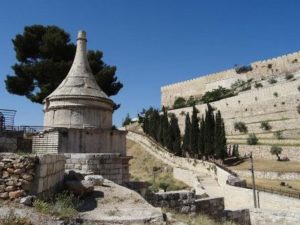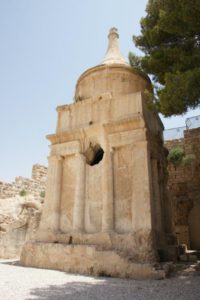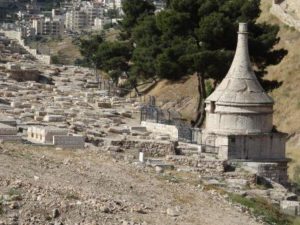Parashat Ki Tetze is a portion that inhabits a huge number of commandments – more that any other portion of the Torah. Some took the trouble and found as many as seventy-four commandments in the portion. Among other issues the portion deals with captives of war, returning of lost items, Shiluach haken, rape that happens in the fields and the rules of building a barrier on the roof. Today I would like to focus on one commandment: the rebellious son. This is definitely one of the most fascinating commandments in the whole bible.
The book of Deuteronomy tells us in chapter 21:
“If a man has a stubborn and rebellious son, that will not hearken to the voice of his father, or the voice of his mother, and though they chasten him, will not hearken unto them; then shall his father and his mother lay hold on him, and bring him out unto the elders of his city, and unto the gate of his place; and they shall say unto the elders of his city: ‘This our son is stubborn and rebellious, he doth not hearken to our voice; he is a glutton, and a drunkard.’ And all the men of his city shall stone him with stones, that he die; so shalt thou put away the evil from the midst of thee; and all Israel shall hear, and fear.” (Deuteronomy, Ch. 21 18-21)
Apparently this is a very problematic commandment and therefore there is no wonder that our sages did whatever they could to make the execution of a rebellious son impossible. Most of chapter eight of Sanhedrin tractate of the Mishna deals with this issue. There it is written that the rebellious son has to be of a certain age, eat and drink specific and rare kinds of food in certain regular amounts. There are also all kinds of limitations on the parents – any deviation from these limitations may still allow the punishing of the son but not his execution. The Talmud takes after the Mishna and it is written that never has there been nor never will there be a rebellious son, however it concludes with rabbi Yonatan’s Saying : ” I saw him and sat on his grave” (Talmud Bavli, Sanhedrin tractate, 71)
Now let’s ask ourselves why would God include in the Bible such a commandment? Why would a person be executed for wild behavior and not for a grave crime? Rabbi Jose the Galilean gives his answer:
“It has been taught: R. Jose the Galilean said: Did the Torah decree that the rebellious son shall be brought before Beth din and stoned merely because he ate a tartemar of meat and drank a log of Italian wine? But the Torah foresaw his ultimate destiny. For at the end, after dissipating his father’s wealth, he would [still] seek to satisfy his accustomed [gluttonous] wants but being unable to do so, go forth at the cross roads and rob.1 Therefore the Torah said, ‘Let him die while yet innocent, and let him, not die guilty.’ For the death of the wicked benefits themselves and the world; of the righteous, injures themselves and the world.”
(Talmud Bavli, Sanhedrin tractate, 72)
I feel that the core of this portion of a rebellious son is about giving parents an educational tool that will help them deal with a son at his adolescence. I think that a lot of parents in Jerusalem agreed with me during long periods of time. The best testimony for that is located in the heart of the Kidron valley. A place known as the tomb of Absalom.
Absalom, King David’s rebellious son has built himself a burial plot in his life: “Now Absalom in his life-time had taken and reared up for himself the pillar, which is in the king’s dale; for he said: ‘I have no son to keep my name in remembrance’; and he called the pillar after his own name; and it is called Absalom’s monument unto this day.” (Samuel 2, 18:18). We can’t know if Absalom was finally buried in this plot. As we all know, Absalom was put to death by Yoav Ben Tzruya after his hair got entangled in the terebinth tree. Yoav’s men took Absalom and ” and cast him into the great pit in the forest, and raised over him a very great heap of stones;” (Samuel 2, 18:17). These events happened probably in the eastern side of the Jordan river, however, in Jerusalem as always tradition is stronger than any historical fact and tradition says Absalom is buried in the Kidron valley.
In that place, at the foot of the Mount of Olives, Jews used to bury their dead since the days of the first Temple. Some think that this is the oldest cemetery in the world that is still being used today. It is not so surprising that the Mount of Olives mountainside and especially the parts next to the place of the Temple served as popular burial spots. During the period of the second Temple a few monumental burial plots were built there. One of which is the place known as the Tomb of Absalom. This is a splendid building dated to the first century A.D, about a thousand years after the time of Absalom. The architectural style is very interesting and includes a representation of the Ionic, Doric and Egyptian orders. This style is not unique to the Tomb of Absalom and can also be found in the Tomb of Jason in Rehavia.
Zev Vilnay, a great researcher of Jerusalem writes that: “It was a custom among the residents of Jerusalem to take their mischief sons to the Tomb of Absalom and there they would bit them and say – behold the fate of the rebellious son whose cursed tombstone is being stoned and damned” (Vilnay, Jerusalem the capital of Israel, The old city and its surrounding, 2, p.243). This custom was known and written about since the 16th century. During the 19th century people could still see the huge pile of stones that was created at the foot of the Tomb of Absalom during hundreds of years of parents trying to reproach their rebellious sons through reading the Ki Tetze portion and walking the streets of Jerusalem.
Back to home page – Tours in Jerusalem
לעמוד בעברית – סיורים בירושלים


